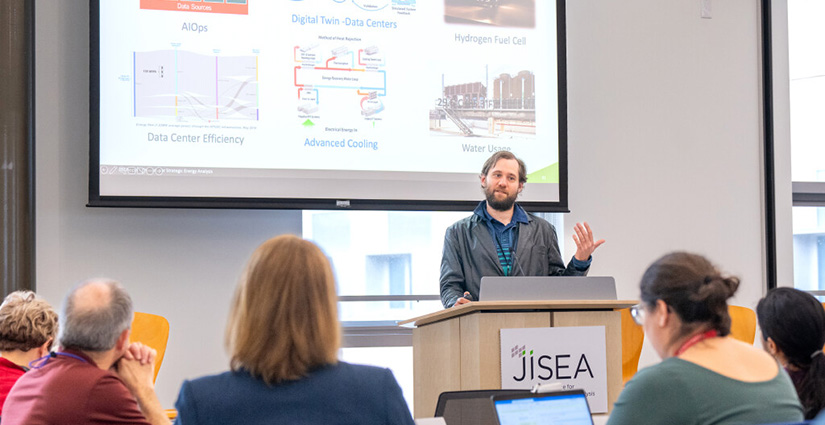Researchers Calculate Path to Greener Computing
NREL Researchers Lead Charge To Reduce Computing Emissions

While enabling innovative technological advancements, the worldwide growth in advanced computing has created a looming energy crisis. Continued innovation and efficiency gains are imperative to avoid future explosive growth in energy used for computing; however, there is little established research on how we can better design, manufacture, use, and dispose of computing devices to reduce their environmental impact.
The U.S. Department of Energy's National Renewable Energy Laboratory (NREL) has emerged as a global leader in green computing, both in making its own computing operations more sustainable and in leading research projects to bring new information and accountability to computing-based research around the globe. As part of this effort, NREL's Joint Institute for Strategic Energy Analysis (JISEA) launched the Green Computing Catalyzer to cultivate and scale the laboratory's green-computing capabilities and establish it as a new research domain.
Long-Standing Commitment to Computing Efficiency
As the home of two high-performance computing (HPC) systems, Eagle and Kestrel, NREL uses advanced computing to power many of its state-of-the-art modeling, simulation, and calculation capabilities. Recognizing the significant energy consumption of these systems, NREL took steps to make their operation more sustainable. In 2014, NREL implemented a water-based cooling system that absorbs the waste heat from the HPC systems and uses it to heat facilities on campus. Researchers also aligned computational jobs with the timing of renewable energy generation, scheduling jobs at optimal times.
In addition to incorporating energy efficiency at the facility and operations levels, NREL also implemented a monitoring system to better understand computational energy consumption from the HPC systems. Eagle, Kestrel, and the previous supercomputer, Peregrine, were instrumented with sensors to measure the energy consumption of nodes and individual components, like processors, memory, and graphics processing units. This monitoring system helps quantify computational energy consumption in a way that allows for comparison and improvement, and NREL is now working to incorporate these insights into its research and computational practices.
Facilitating Energy-Efficient Computing for HPC Users
Researchers from NREL's Computational Science Center are partnering with the JISEA Green Computing Catalyzer to make the energy consumption data gathered from the supercomputer sensors available to all NREL researchers.
"We want to encourage researchers to include computing energy consumption data as a part of their publications," said Charles Tripp, senior researcher in the Computational Science Center and lead of the JISEA Green Computing Catalyzer. "This draws attention to the energetic cost of computing and sets a standard for accountability in this area of research."
When configuring computational experiments, researchers often compare the performance metrics of various models and algorithms to choose the configuration that will produce the best quality of results. By making algorithmic energy consumption information accessible, researchers will be able to compare the environmental impact of various computing approaches. The end goal is for any researcher who uses NREL's computing facilities to understand the energy consumption of their computations and report some degree of the energy data in their publications.
"NREL plans to roll this resource out to the entire HPC user community, so that any researcher using our supercomputers can have the information necessary to choose not only the best raw performance but also optimal energy efficiency," said Aaron Anderson, group manager of NREL's Advanced Computing Operations group. "Over time, we plan to include more detailed information to make these energy-efficient considerations more useful."
Leading Green Computing Efforts Outside of NREL
In addition to making its own computing more energy efficient, NREL is working to equip researchers around the world with the tools needed for more energy-efficient algorithm design.
Researchers from NREL's Computational Science Center recently compiled a public data set of real-world algorithmic performance metrics and ran millions of computational experiments over three HPC systems, reaching a rate of 4 million node hours per year. This substantial amount of computing provided data on the performance of various configurations of algorithms, input data, and hardware. As part of the work with the JISEA Green Computing Catalyzer, researchers are now working to augment the data set with energy efficiency data. The data set, called the BUTTER Empirical Deep Learning Dataset, is the first of its kind.
"There are very few publications out there in computer science that are publishing the energy consumption of their approaches on real systems," Tripp said. "While most publications provide estimates, publishing real-world data is a new frontier."
Making the data available can help researchers inside and outside of NREL determine how to spend their computational energy wisely and what energy costs they might incur when training models. Researchers are also working to compile and publish similar data sets for cryptocurrency and blockchain calculations.
A Plan for the Future of Green Computing Research
As green computing research gains greater attention and efforts expand, NREL plans to diversify the types of systems it is measuring to get a more comprehensive understanding of computational energy consumption. Moving forward, researchers will identify other significant computational workloads at NREL—such as computational fluid dynamics and wind resource forecasting—and build similar data sets to identify more efficient approaches.
This foundational work will help establish optimizing energy efficiency of different computational approaches, algorithms, and data management practices as a long-term capability at the laboratory.
"Investment in computing has traditionally focused on using it as a vehicle to do more complex clean energy research," Tripp said. "But we need to start looking at computing as its own energy efficiency challenge and research domain."
To learn more, read about the Green Computing Catalyzer and NREL's high-performance data centers.
Last Updated May 28, 2025
